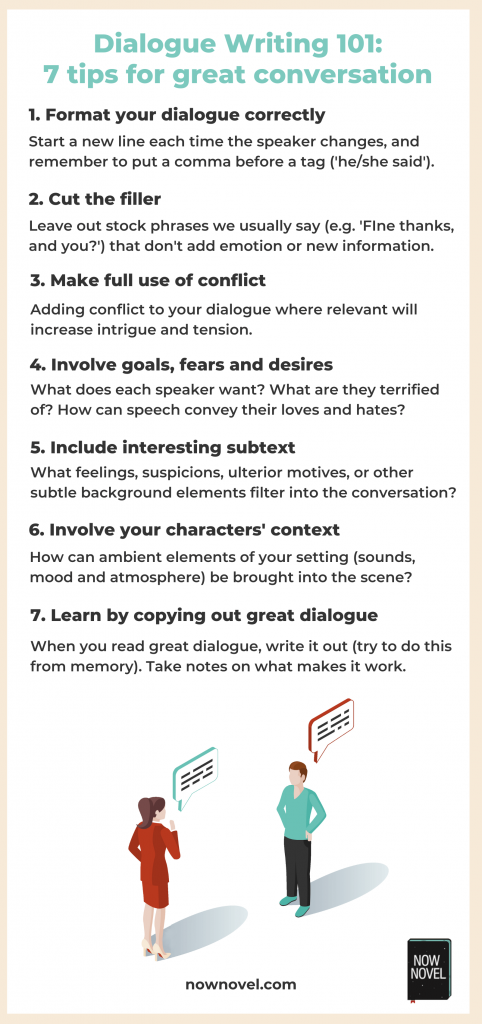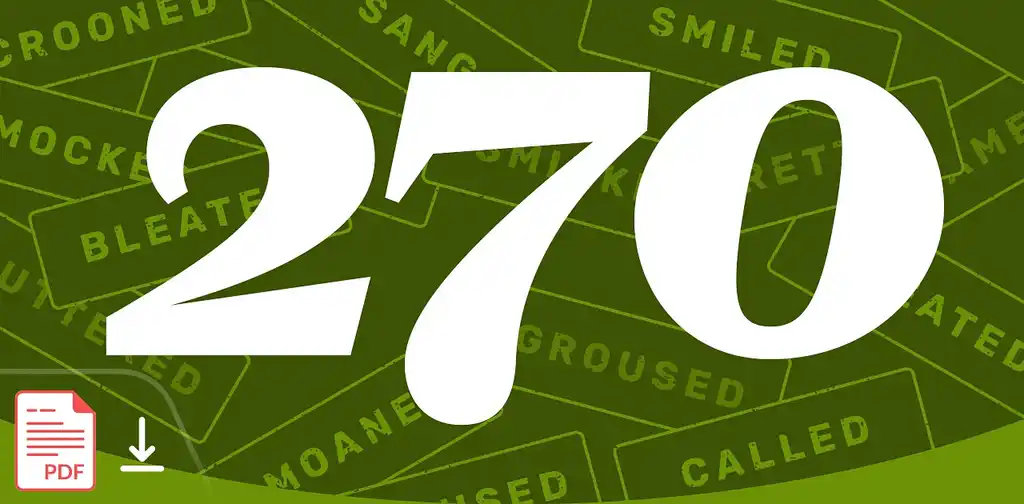Learning how to write dialogue in a story is crucial. Writing gripping conversations that include conflict and disagreement and further your story will make readers want to read on. Here are 7 steps to improve your dialogue writing skills:
7 steps to write better dialogue:
- Learn how to format dialogue
- Cut filler
- Include conflict and disagreement
- Involve characters' goals, fears and desires
- Include subtext for subtle gestures and effects
- Involve context for tone and atmosphere
- Learn by copying out great dialogue writing
Let's expand these ideas:
1. Learn how to format dialogue
You should always leave your reader caught up in your dialogue, not lost in it. Good formatting is key to making dialogue enjoyable and effortless to read [that's why formatting is the focus of Week 1 of our writing course, How to Write Dialogue].
Here are some guidelines for how to write dialogue for maximum clarity:
a) Every time you change speaker, start a new, indented line
Follow this convention because it's all too easy to lose track of who's saying what in dialogue. An example of good format:
"What were you thinking?" Sarah frowned.
"I wasn't. Thinking, I mean," Tom admitted.
b) Always use opening and closing speech marks
If you write in US English, it's standard to use double quotation marks for dialogue. In UK English, single quotation marks suffice.
There is an exception: If you have the same character speaking across multiple paragraphs, uninterrupted (if a character is telling a long story), use an opening speech mark for each paragraph and only use a closing speech mark at the end of the last paragraph before narration resumes or another character speaks.
c) Place all dialogue punctuation inside speech marks
In the above example, the question mark in Sarah's dialogue comes before the closing speech marks, not after.
If the end of a line of dialogue is also the end of the sentence, place the period or full stop before the closing speech marks because it's part of the rhythm of the speech. It's part of character's own coming to a stop (it doesn't lie outside their speech):
"That's your problem," Sarah chided, "you only ever rely on your gut."
The best policy when formatting dialogue is to check published books and compare multiple dialogue extracts. Investigate what the most common practice is in books by published authors in your country, and remember to be similarly consistent.
For other ideas on how to format dialogue, read our dialogue pointers.
2. Cut filler
In strong dialogue, there is no filler. If characters speak on the phone, there are no 'may I speak to's' or 'Please hold's'. Cut all filler from your dialogue. Launch straight into any phone conversation. For example:
"Yes?"
The voice on the other end of the line was doubtful; suspicious.
Sometimes, filler material such as an introduction between characters, is necessary. Yet take the opportunity to weave in colourful character description. For example, here is an introduction in Charles Dickens' Great Expectations that is full of character:
'...Joe was smoking his pipe in company with Mr. Wopsle and a stranger. Joe greeted me as usual with "Halloa, Pip, old chap!" and the moment he said that, the stranger turned his head and looked at me.
He was a secret-looking man whom I had never seen before. His head was all on one side, and one of his eyes was half shut up, as if he were taking aim at something with an invisible gun.'
Note that Joe's greeting is just four words. Yet Dickens instead adds narration around Joe's voice, giving detailed character description.
'Filler' includes unnecessary dialogue tags. Instead of an endless 'he said, she said', see where you can replace a tag with a gesture or motion that supplies more story information. Compare:
"So you're leaving..." he said.
"I thought that much was obvious," she said.
The dialogue tags have a monotonous, repetitive effect. You could either leave them out entirely (if the preceding scene's context makes it clear who says which line), or you could add gesture that attributes the dialogue the same:
"So you're leaving..." He folds his arms, standing in the doorway.
"I thought that much was obvious." Pausing her packing, she looks over her shoulder at him, resisting the sudden impulse to turn and face him.
Here the dialogue supplies a lot more detail about the emotions of the scene, while avoiding clunky repetition of a standard dialogue writing device.
Another type of filler in dialogue is excessive adverbs. Let the words themselves convey tone and mood:
3. Include conflict and disagreement
Key to writing great dialogue is knowing how to write dialogue involving confrontation or disagreement. In real life, we might go weeks without a single terse or grumpy word to another person. Yet in stories, conflict and confrontation in dialogue supply narrative tension and this keeps the story compelling.
If everyone in your novel gets on swimmingly with everyone else, this could result in dull dialogue.
For example, the verbal sparring between Estella and Pip in Great Expectations creates tension, as we see Estella taunt and test Pip by insulting and goading him. Her dialogue and behaviour is consistent with Estella's backstory. Her legal guardian, Miss Havisham, once jilted by a lover, has turned the young Estella against boys and sentimentality:
"Well?"
"Well, miss?" I answered, almost falling over her and checking myself.
"Am I pretty?"
"Yes; I think you are very pretty."
"Am I insulting?"
"Not so much so as you were last time," said I.
"Not so much so?"
"No."
She fired when she asked the last question, and she slapped my face with such force as she had, when I answered it.
"Now?" said she. "You little coarse monster, what do you think of me now?"
"I shall not tell you."
Conflict and disagreement might not be anything so dramatic as a physical altercation mid-dialogue. It could be something as small as two traveling characters arguing over a map in the middle of a maze-like city. But these moments of tension are useful for illustrating how your characters react (and interact) under pressure.

4. Involve characters' goals, fears and desires
Remember that characters don't always need to be honest, willing or helpful conversation partners. They may be cryptic and misguiding. They can trip each other up with questions and evasive responses. This is particularly the case in dialogue where characters hold different levels of power (in an interrogation or courtroom cross-examination, for example).
Like an unreliable narrator, an unreliable character in conversation could feed your protagonist false information, out of their own motivation.
In every dialogue, keep in mind what motivates each character.
Before you start writing an important section of dialogue, ask yourself:
- What does each character want at this point in the story? What do they fear?
- How might each character's goals, fears and desires shift or affect this particular conversation?
When you connect character's conversations to their personal paths and goals in your story, even if just subconsciously, this will help you write more directed, purposeful-seeming dialogue. This is particularly important in genres such as crime and mystery, where characters gaining information from others forms a big part of the narrative.
This leads into subtext in dialogue:
5: Include subtext for subtle gestures and effects
Subtext in dialogue is as important as context. It's the 'why' (in addition to the where) underlying characters' conversations. If, for example, a spouse suspects their partner of cheating, this underlying mistrust could be the subtext for an unrelated conversation about dinner plans with their friends. The subtext explains the turn the conversation takes:
"The Watsons have invited us for dinner this Saturday." She beamed.
"What, again? That's the third time this month. You seem thrilled. Next they'll be inviting you to a menage a trois."
She didn't understand why he brought every conversation to sex lately. It seemed a new infatuation. And why did he always state the obvious about her every mood and gesture?
Here, the subtext of suspicion and mistrust makes the dialogue interesting. A mundane conversation about dinner plans becomes a story in miniature about jealousy and miscommunication.

6. Involve context for tone and atmosphere
The context in dialogue (another subject we explore in How to Write Dialogue) is important. The context of a conversation - the place where the conversation occurs, and the circumstances leading to it - gives us important details. Mastering using context in dialogue is important because it will help you avoid using adverbs with dialogue tags that make the author's shaping hand too visible. For example:
"I think someone might be in the house," she said softly.
Here, you could use the stronger tag 'she whispered' to convey volume and eliminate the unnecessary adverb. Yet you could also use context from setting and narration to convey the softness of the conversation here:
For weeks they'd been tempted to enter the dilapidated house. It was a late, windy Friday afternoon when temptation got the better of them. They'd knocked nervously first, not knowing what they'd do if someone answered. After a hushed minute, they'd crept and tip-toed inside, while the paint-stripped front door creaked closed. They were huddling together and shuffling down a dark, musty corridor when she heard a sudden noise from upstairs.
"I think someone might be in the house..." Her eyes were wide, her voice barely audible.
Here you don't need an adverb - the context supplies plenty of detail to suggest the character's fear and the house's eerie stillness.
When thinking about the context of characters' conversation, remember Toni Morrison's dialogue writing advice:
"I never say ‘She says softly’ [...] If it’s not already soft, you know, I have to leave a lot of space around it so a reader can hear that it’s soft.'
7. Learn by copying out great dialogue
Many great artists in all mediums - art, literature, music - have learned and honed their craft by copying out effective work by their peers and predecessors. To write great dialogue, write down a few lines of dialogue in a journal when you come across dialogue in a story that makes you say 'wow!'
Create your own treasure trove of inspiring dialogue snippets that you can dip into whenever you need a reminder of how to write dialogue that builds character and story.
Want helpful feedback on sections of your dialogue? Enroll in our four-week course How to Write Dialogue and get an editor's feedback.












Great tips, thanks!
Charlotte Rains Dixon - Over 8 years ago
It's a pleasure, Charlotte. Thanks for reading!
Bridget At Now Novel - Over 8 years ago
Gud one ...actually awesome
Karthik Krish - Over 7 years ago
Found perfection place
Faheem Rafiq - About 4 years ago